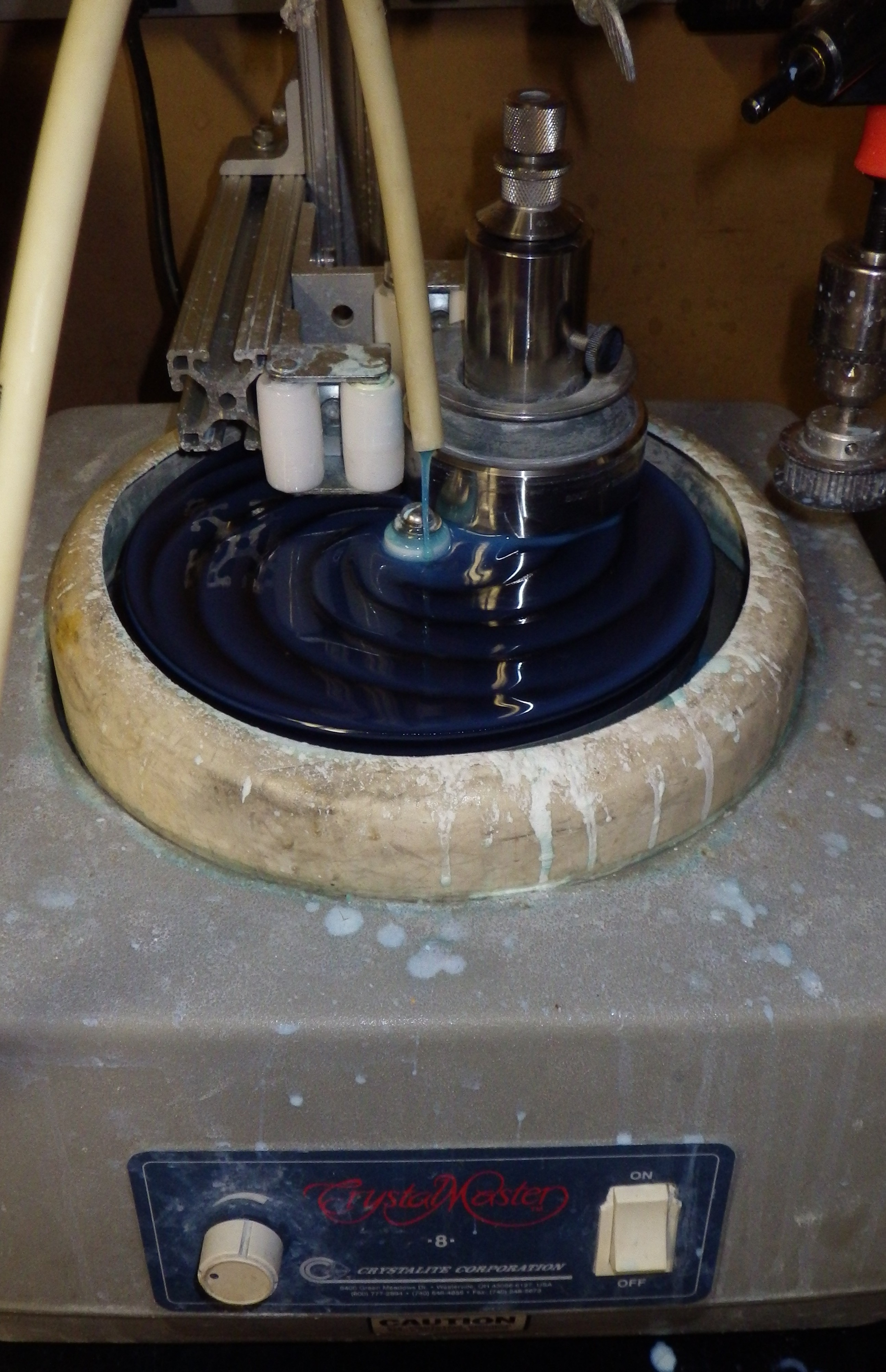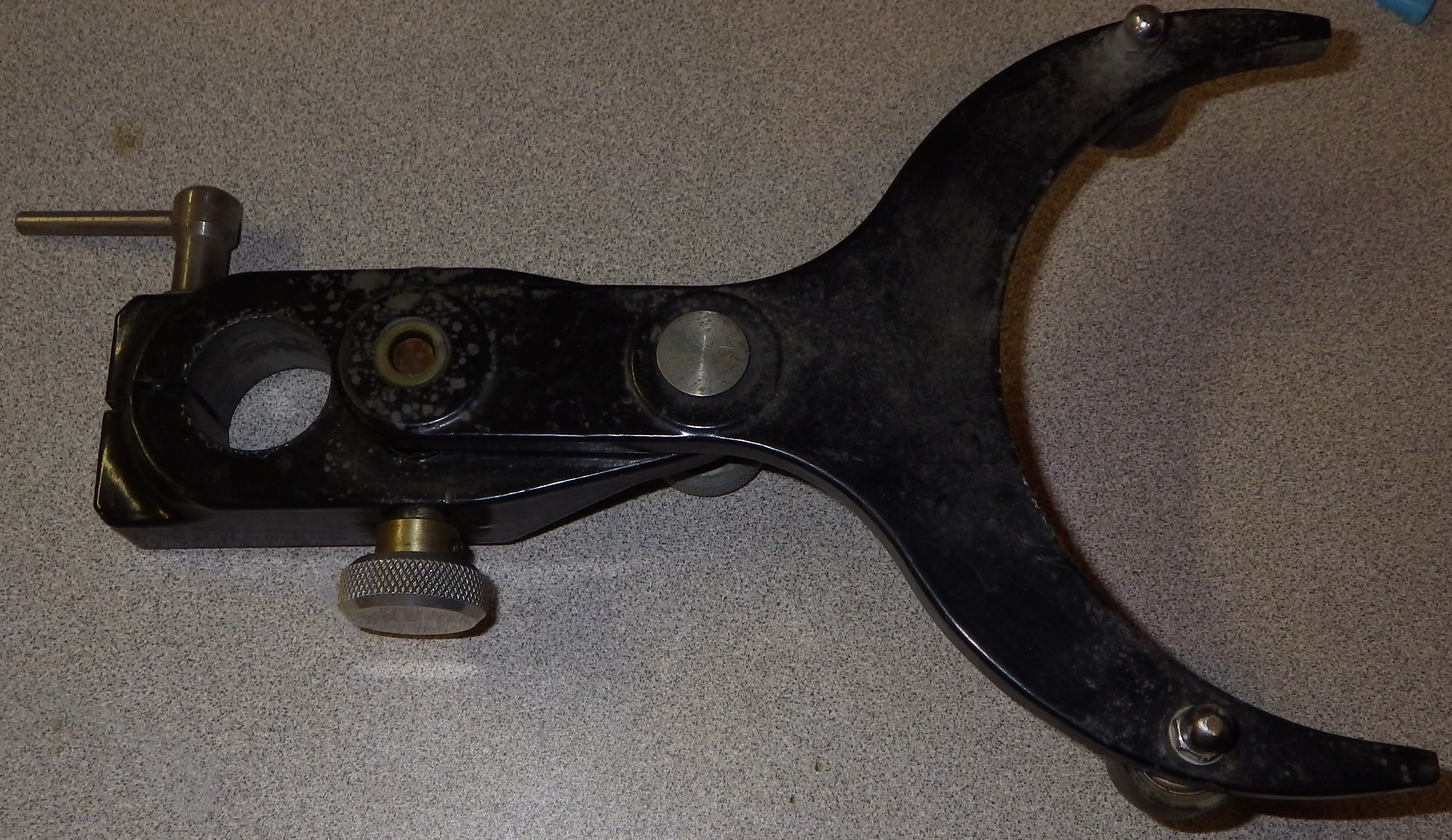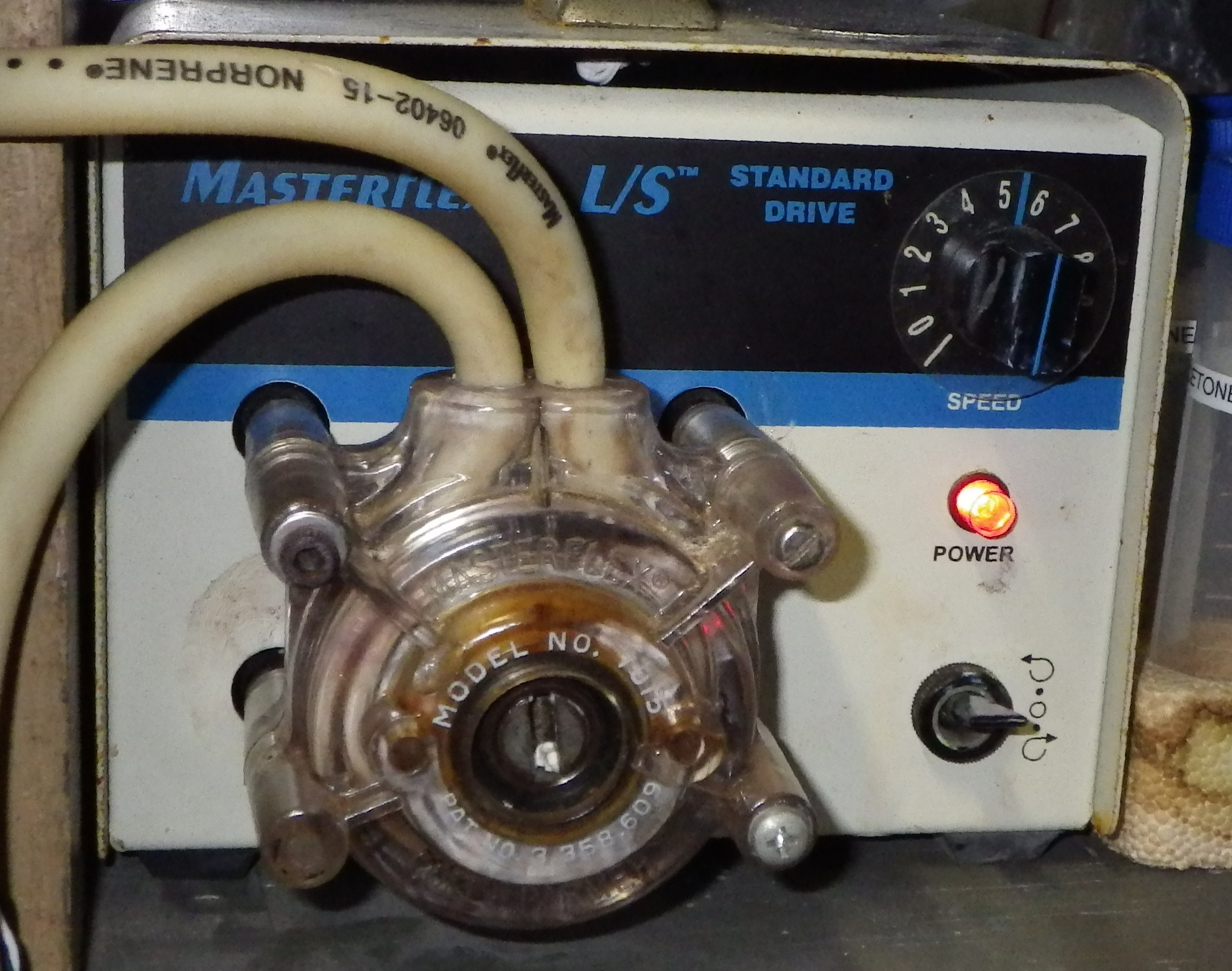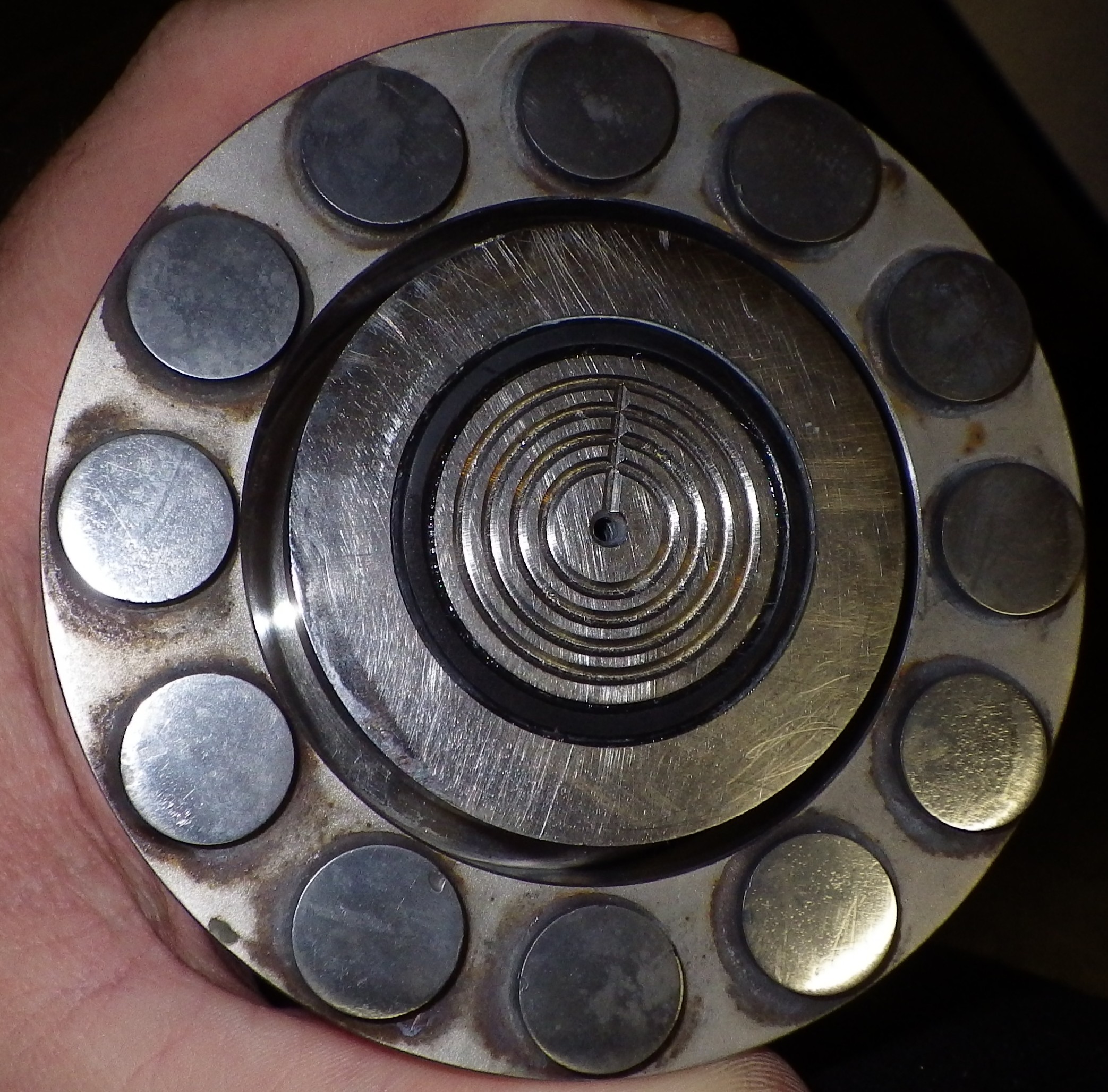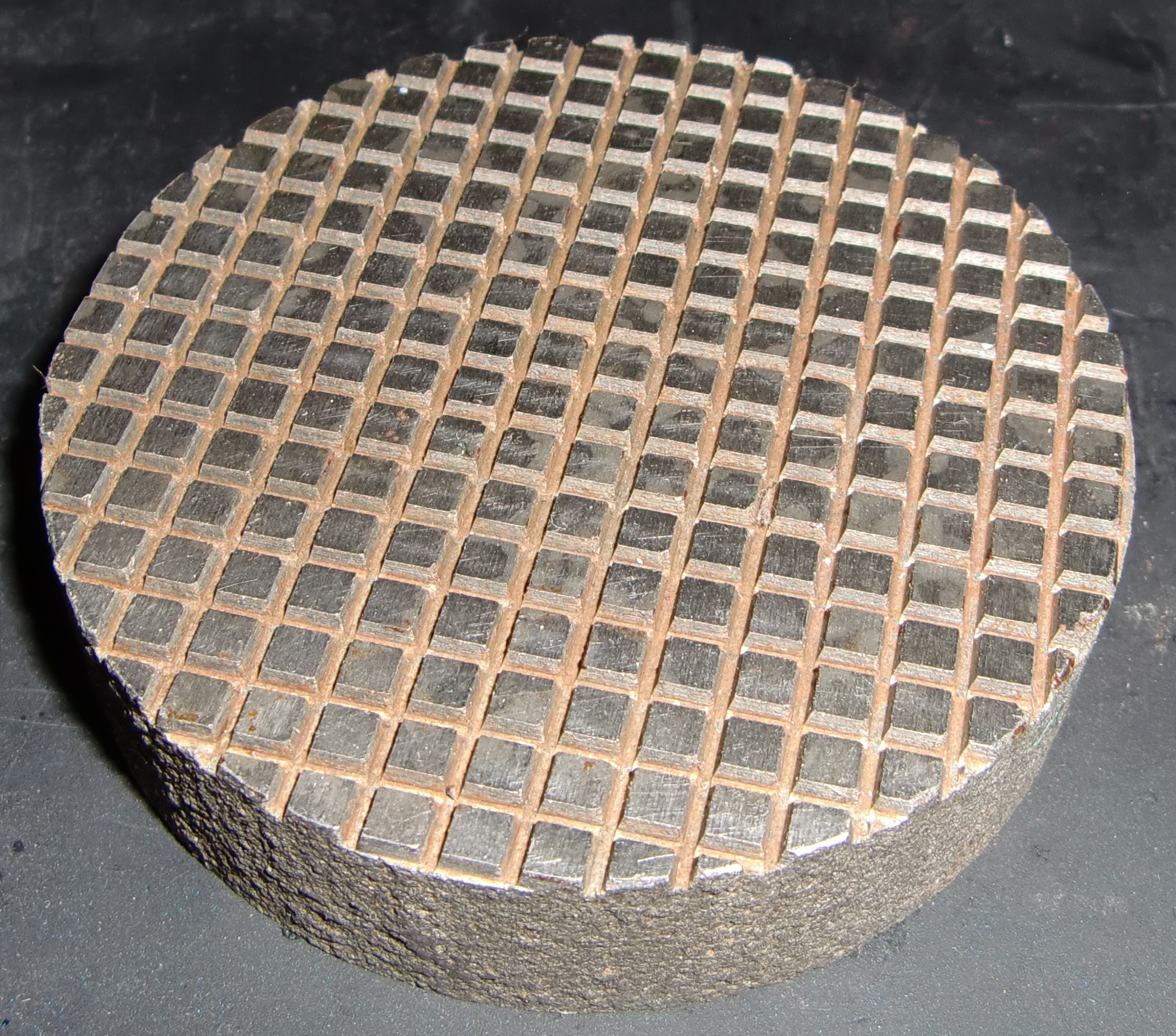This is an old revision of the document!
Table of Contents
Setup types
Machine
Above: CrystalMaster 8 with South Bay Technology jig. Drive mechanism seen at right although belt is not attached
Samples can be polished manually by moving them in a figure 8 pattern for reasonably even polishing. However, this takes a while and can be tiring. Thus, most all IC work is done on a machine for so called “automatic lapping”.
The main components of a typical lapping machine:
- Lapping plate or “platen”: a ridged surface that spins against sample
- Platen drive motor: motor to spin lapping plate
- Speed controller: how fast the platen rotates
- Fixture drive motor: motor to put a controlled spin on lapping fixture
- Slurry pump: recirculates CMP solution after coming off of the platen
- York support: keeps fixture in place so it doesn't spin off
- Slurry reservoir: holds bulk of slurry solution
- Slurry filter: filters out contamination so it doesn't scratch the sample
- Splash guard: as disk spins silica spins out and would make a huge mess if not recaptured
Platen
Beyond IC RE, platen can be made of a variety of materials including:
- Cast iron
- Diamond
- Poromeric pad
However, cast iron and diamond are too abrasive for IC RE and so only polymeric pads are typically used.
Some machines can take magnetic apds such that one can switch, say, between a diamond and cast iron pad. As you should really only be using polymeric pads this feature will probably be less useful.
Above: typical stackup seen on JM machine consisting of (top to bottom):
- MTI 8“ Poromeric Polishing Pad (PSA) for final polishing - EQ-PP-8PSA-PC
- Two 8” Mater Plate ( Backing Plate ) for PSA Diamond plate, Sand Paper & Polishing Pad - EQ-MBP-8-2
- CrystalMaster 8 master lap
The first, the poromeric pad is the most important. It is essentially a soft pad to move abrasive around without actually scratching the die. The next forms a smooth surface on which the poromeric pad rests. Finally, the master lap is the interface to the machine itself and has ridges to keep backing plate in plate.
Originally the machine had a steel backed diamond pad directly on the master lap (attached with adhesive, removed with acetone + heatgun). In this setup the steel backing is much stiffer than the polishing pad and so serves as the backing plate.
York support
Above: york support from Logitech lapping machine. Note the screw on the side to make fine angle adjustments
Most machines have a stiff support arm with two rollers on it. This allows the fixture to rotate along with the machine to evenly lap the sample (planetary motion). They are usually attached to a sturdy post built into the machine
Alternatively, some machines (ex: Allied Tech's) attach the sample to a motor drive mechansim that directly supports the sample
Lost cost alternative: attach some rollers to a steady post and align to lapping machine
Some machines incorporate a fixture drive mechanism into the support arm
Nozzle
Typically uses ridged flexible nozzles like used on CNC machine coolant systems.
JM setup: open tube drips down. I originally used a nozzle but it was harder to clean (was drying out/clogging) and wasn't sure if it really helped since lapping jig conditions the pad
Slurry pump
Above: JM setup pump head
Because the abrasive is both corrosive and abrasive, it would be difficult to design a traditional mechanical pump to handle it. Fortunately, the flow rate is small which lends it well to peristaltic pumps.
JM setup:
- Cole Parmer Masterflex L/S
- Cole Parmer 7015 drive head (milled down to fit)
- Cole Parmer 06402-15 (MasterFlex Norprene (Neoprene))
Low cost alternative: put a reservoir above the machine and let it drip down (ex: sepreatory funnel w/ stopcock). You'll have to watch things more closely and the flow rate probably won't be as smooth as pressure will vary with fluid height. As proper flow rate is in fact pretty low should work well enough in practice. Even some higher end machines (ex: Allied Tech) ship with sepratory funnels instead of slurry pumps
Sample holding ("fixturing")
Above: bottom of South Bay Technology jig showing relieved sample holder and carbide pads. Note the center is hollow to allow air to escape for easy sliding
The device used to hold a sample to be lapped is called a lapping jig or lapping fixture. Typically made of stainless steel with carbide pads to resist the corrosive CMP solution. For example, the South Bay Technology 150 uses 303 SS with tungsten carbide pads [ instruction manual ].
Alternatively, the most basic method is to simply hold a die on a finger and press it into a spinning wheel. See tutorial. You won't get as uniform as a polishing but it should suffice if you just care about one particular section
Height control
Most fixtures have a fine pitch threaded on the ram going down the center bore. This allows it to be precision adjusted and locked to a nut to control precisely how much material to be taken off
Most fixtures also have one or two micrometers for monitoring sample height
Tripod
These are like above but include three precision setscrews for adjusting the angle of the center slide relative to the polishing plane. This helps to correct small mounting imperfections. These fixtures are much more expensive.
Example fixture: Logitech PP6
Pneumatic
Most fixtures rely on adding weights to vary the pressure. However, higher end fixtures instead accept air feeds that can be used to more accurately regulate the force applied.
Example fixture: MTI EQ-PF-4-1V
Conditioning ring
A ceramic ring around the sample holder evens out the slurry and filters out some impurities to the sample holder inside. The MTI low cost jig uses a stainless ring instead, I don't know if there is an advantage to one over the other.
The South Bay Technology jig above has a small rubber ring that might have been intended to be some sort of conditioner but unclear how. In any case the carbide pads seem to provide some conditioning
Encased
TLDR: these fixtures are generally intended for sectioning and are not precise enough for parallel polishing
Some machines are designed for samples encased in blocks intended for metallurgy. These are also useful for irregularly shaped samples but these are rarely encountered in IC RE. There are two methods usually employed to encase specimins:
- Epoxy fill (most common)
- Compression mounted.
Example fixture: MTI EQ-PF-3H1W2
Epoxy mounting
TLDR: not suitable for parallel polishing
The epoxy mounting method is nice because is very safe to specimens. Epoxy isn't super cheap but is inexpensive compared to the net cost of doing this type of analysis. The sample is simply put into a well (typically made of silicone I think) that matches the machine size and epoxy is cast into a block. Different epoxies are used depending on requirements (ex: 1 hour cure for quicker processing vs 24 hour cure for higher quality cast).
I've had problems with samples floating up from epoxy getting under them. Most be a hard surface and its probably a good idea to press the die down during casting. A more viscous epoxy might work well at the cost of creating bubbles. Overall, the contamination and uncertainty this introduces doesn't seem to be the best approach.
Compression mounting
Compression mounting is quick and inexpenTLDR: not suitable for parallel polishing
sive per sample. It is intended for sectioning where the particular angle sectioned isn't important. Therefore, its not suitable for parallel polshing. Additionally, it uses high force and the the mix may need to be hot which can risk damaging specimens. See for example MTI's compression mounting powder (EQ-HM-Powder5L) + sample press EQ-MP-300.

